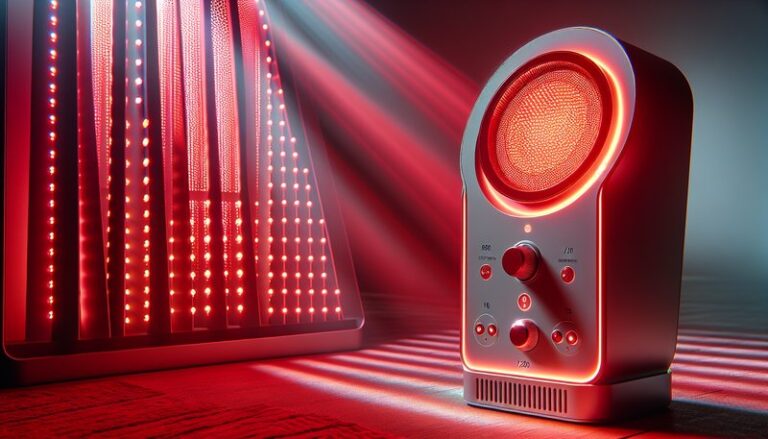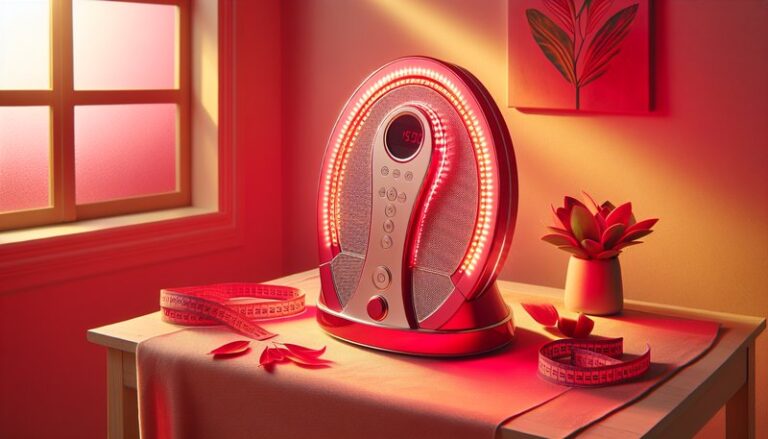Does Red Light Therapy Help With Weight Loss?
Does Red Light Therapy Help With Weight Loss?
Have you ever wondered if a simple light therapy could aid in your weight loss journey?
In recent years, red light therapy has gained popularity as a potential tool for weight loss, among other benefits. This article will explore what red light therapy is, examine its purported benefits for weight loss, consider its effectiveness, and explore alternatives to this treatment. By the end, you will have a clearer understanding of whether red light therapy is a viable option for your weight management goals.
Key Takeaways
- Red light therapy may promote fat reduction by enhancing cellular metabolism and energy production.
- While there are positive anecdotal reports, scientific research regarding its effectiveness for weight loss is still limited.
- It’s important to consider lifestyle factors and potential alternatives rather than relying solely on red light therapy.
What is Red Light Therapy?
Red light therapy (RLT), also known as low-level laser therapy (LLLT) or photobiomodulation, involves the use of specific wavelengths of light to penetrate the skin, targeting cells for various therapeutic benefits. The light typically ranges from 600 to 1,000 nanometers and is believed to stimulate cellular function, enhance energy production, and promote healing.
Red light therapy has been used in a variety of settings, from dermatology to pain management, showing potential benefits in skin rejuvenation, inflammation reduction, and enhanced recovery for muscles post-exercise. But what does this mean for those seeking weight loss solutions?
What are the Benefits of Red Light Therapy?
Before diving back into the topic of weight loss, let’s explore the benefits that red light therapy offers.
Enhanced Fat Oxidation
Research suggests that red light therapy can help enhance fat oxidation. Some studies have indicated that exposure to red and near-infrared light may stimulate the mitochondria in our cells, increasing energy production and promoting the breakdown of fat for fuel.
Reduced Inflammation
Red light therapy is known for its anti-inflammatory properties. By reducing inflammation, the body can function more effectively, which is crucial for maintaining a healthy metabolic rate and supporting weight loss efforts.
Improved Recovery and Muscle Performance
For those looking to lose weight through exercise, RLT could aid in recovery and performance. By enhancing blood flow and promoting tissue repair, individuals may experience less downtime between workouts, allowing for more consistent training sessions.
Support for Skin Health
Interestingly, while not directly linked to weight loss, improving skin elasticity and reducing the appearance of cellulite with red light therapy can boost confidence and encourage individuals to remain committed to their weight loss goals.
Is it Possible to Use Red Light Therapy for Weight Loss?
Using red light therapy for weight loss is certainly feasible and many people report success, but it’s important to approach it with realistic expectations. RLT should be considered as a complementary tool rather than a stand-alone solution.
What are the Advantages of Using Red Light Therapy for Weight Loss?
One major advantage of using red light therapy is its non-invasive nature.
Convenient and Painless Treatment
Most red light therapy sessions are quick, lasting between 10 to 30 minutes, making it an easy addition to one’s lifestyle. Unlike surgical options, RLT causes no discomfort and has minimal to zero downtime.
Potential Synergy with Other Weight Loss Methods
When combined with a balanced diet and regular exercise, red light therapy can enhance the overall approach to weight management, potentially leading to better results.
Accessibility of Home Devices
With the advancement of technology, various devices are now available for home use. This allows individuals to incorporate RLT into their daily routines conveniently and affordably.
What are the Disadvantages of Using Red Light Therapy for Weight Loss?
Despite the advantages, there are some downsides to keep in mind.
Limited Scientific Evidence
The scientific evidence supporting red light therapy specifically for weight loss is still emerging. While preliminary studies show promise, more rigorous research is needed to establish its effectiveness conclusively.
Potentially High Costs
Depending on the type of device or treatment you choose, initial investment costs can be high, and insurance coverage may vary.
Not a Substitute for a Healthy Lifestyle
Relying solely on red light therapy without engaging in proper nutrition and exercise may yield minimal results. It should never replace a holistic approach to weight management.
What are the Things to Consider Before Using Red Light Therapy for Weight Loss?
If you are considering using red light therapy to assist with weight loss, there are several important factors to take into account.
Consultation with a Healthcare Provider
Before starting any new therapy, especially if you have underlying health conditions or are pregnant, it’s wise to consult a healthcare professional to discuss the appropriateness of RLT for your situation.
Setting Realistic Goals
Understand that red light therapy can enhance your weight loss efforts, but it is not a miracle solution. Set achievable goals and combine therapy with a balanced diet and exercise.
Device Quality and Safety
If you opt for at-home devices, ensure they meet safety standards and are produced by reputable manufacturers. Quality varies widely between products, and poorly designed devices may be ineffective or unsafe.
Read the thorough analysis How Fast is Red Light Therapy?
What are the Alternatives to Red Light Therapy for Weight Loss?
While red light therapy offers potential benefits, there are several other alternatives that can also assist in weight loss.
Dietary Changes
Creating a caloric deficit through a nutrient-dense diet is one of the most effective ways to lose weight. Consider consulting a nutritionist for personalized plans.
Exercise Programs
Increasing physical activity through structured exercise routines can greatly aid in weight loss. Both cardiovascular activities and strength training play essential roles in maintaining a healthy weight.
Behavioral Therapy
Cognitive-behavioral therapy (CBT) can address psychological aspects of eating and help develop healthier habits.
Intermittent Fasting
This eating pattern alternates between periods of eating and fasting, promoting weight loss through improved metabolic markers and better appetite regulation.
Conclusion: Is it Recommended to Use Red Light Therapy for Weight Loss?
In summary, red light therapy shows promise as a supplementary method for enhancing weight loss efforts through improved fat oxidation, reduced inflammation, and aid in recovery. However, it should not be considered a standalone solution. For those keen on weight loss, integrating RLT with a comprehensive program that includes diet and exercise will likely yield the best results.
Frequently Asked Questions
Is red light therapy safe?
Yes, red light therapy is generally considered safe when performed correctly, with minimal side effects reported. However, it’s important to follow guidelines and consult with professionals if necessary.
How often should I undergo red light therapy for weight loss?
Most protocols suggest 2-3 sessions per week, but this can vary based on individual goals. Always refer to the manufacturer’s guidelines or a healthcare provider’s recommendations.
Can red light therapy replace exercise?
No, red light therapy is not a substitute for exercise. It is best used as a complementary tool alongside regular physical activity and a healthy diet.
Will I see immediate results with red light therapy?
Results may vary. Some individuals report improved energy and recovery soon after therapy, while noticeable weight loss may take several weeks or longer to manifest.
Can anyone use red light therapy?
Most people can safely use red light therapy, but you should consult with a healthcare provider if you have specific health concerns or conditions.
Get the complete insights in Contraindications for Red Light Therapy






